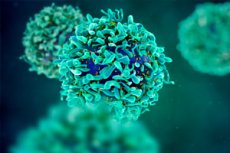New publications
Experimental cancer drug may help clear HIV from brain cells
Last reviewed: 02.07.2025

All iLive content is medically reviewed or fact checked to ensure as much factual accuracy as possible.
We have strict sourcing guidelines and only link to reputable media sites, academic research institutions and, whenever possible, medically peer reviewed studies. Note that the numbers in parentheses ([1], [2], etc.) are clickable links to these studies.
If you feel that any of our content is inaccurate, out-of-date, or otherwise questionable, please select it and press Ctrl + Enter.

An experimental drug originally developed to treat cancer may help clear brain cells infected with HIV, according to a new study from Tulane University.
For the first time, researchers at the Tulane National Primate Research Center have found that an anti-cancer drug significantly reduces levels of SIV, the nonhuman primate equivalent of HIV, in the brain by targeting and killing specific immune cells that harbor the virus.
The findings, published in the journal Brain, are a significant step toward eliminating HIV from hard-to-reach reservoirs where the virus eludes effective treatment.
Importance of the study
"This study is an important step in combating HIV-related problems in the brain, which continue to affect people even with effective antiretroviral therapy. By focusing on infected cells in the brain, we can clear the virus from these hidden areas, which has been a major challenge in treating HIV," said Woong-Kee Kim, PhD, lead author of the study and associate director of research at the Tulane National Primate Research Center.
Problems with Current HIV Treatment
Antiretroviral therapy (ART) is an essential part of successful HIV treatment, keeping the virus at undetectable levels in the blood and turning HIV from a deadly disease into a manageable condition. However, ART does not completely eradicate HIV, requiring lifelong treatment. The virus persists in “viral reservoirs” in the brain, liver, and lymph nodes, where it remains out of reach of ART.
The brain has been a particularly difficult area to treat because of the blood-brain barrier, which protects it from harmful substances but also blocks treatment, allowing the virus to persist. In addition, cells in the brain known as macrophages live for a very long time, making them difficult to kill once infected.
Influence of macrophages
Macrophage infection is thought to contribute to neurocognitive dysfunction, which affects nearly half of people with HIV. Clearing the virus from the brain is critical to comprehensive HIV treatment and could significantly improve quality of life for those with HIV-related neurocognitive problems.
Research method
The researchers focused on macrophages, a type of white blood cell that harbors HIV in the brain. Using a small molecule inhibitor to block a receptor that increases in HIV-infected macrophages, the team successfully reduced the viral load in the brain. This approach effectively cleared the virus from brain tissue, providing a potential new avenue for treating HIV.
Research results
The small molecule inhibitor used in the study, BLZ945, has previously been studied for therapeutic use in amyotrophic lateral sclerosis (ALS) and brain cancer, but never before in the context of clearing the brain of HIV.
The study, conducted at the Tulane National Primate Research Center, used three groups to model human HIV infection and treatment: a control group with no treatment, and two groups that received either a low or high dose of the inhibitor for 30 days. The high dose of treatment resulted in a significant reduction in the number of cells expressing HIV receptors, as well as a 95-99% reduction in viral DNA in the brain.
Aside from reducing viral load, the treatment had no significant effect on microglia, the brain's resident immune cells that are important for maintaining a healthy neuroimmune environment. There was also no evidence of liver toxicity at the doses tested.
Next steps
The next step for the research team will be to test this therapy in combination with ART to assess its effectiveness in a combination treatment approach. This could pave the way for more comprehensive strategies to eradicate HIV from the body entirely.
